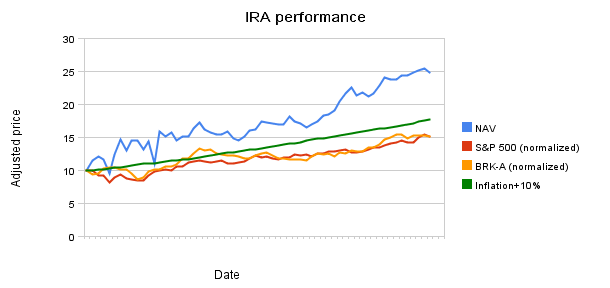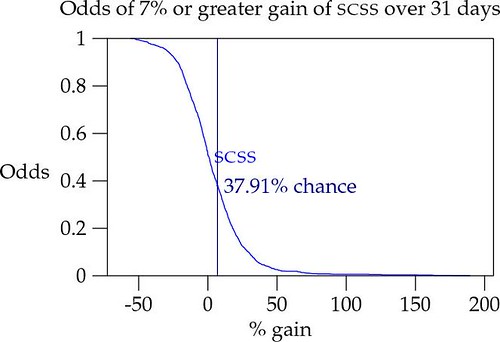I've owned Oracle for just over five years, which probably means I'm biased toward favorable information about the company. Oracle had an almost perfect 4th quarter this year. I couldn't really find much to complain about, so I was interested to read about "Oracle's Mixed Message" in BusinessWeek. Here is the meat of the current bear case in the article:
Oracle's fourth-quarter sales of new business applications licenses, a predictor of future sales, rose just 5% in the region that includes the U.S., to $415 million. Excluding Oracle's $3.3 billion acquisition of Hyperion Solutions on Apr. 23, U.S. sales were essentially flat. "That's where people are a little concerned," says Peter Kuper, an analyst at Morgan Stanley (MS).During the conference call, Ellison blamed slow U.S. applications sales growth on a tough comparison with the fourth quarter of 2006, when Oracle reported particularly strong results.
Oracle's overall new license sales for applications rose 13%, to $726 million. UBS (UBS) analyst Heather Bellini said in a research note that new applications license sales fell short of her expectation for 14% growth, and she wants to see more numbers from Oracle's recent acquisitions to figure out how quickly it's picking up share from SAP. Bellini expects SAP to post 10% new license growth for applications in its current quarter.
Oracle announced five acquisitions during the fourth quarter, including Hyperion Solutions, a maker of business-intelligence software, and Agile Software, which helps companies manage product portfolios (see BusinessWeek.com, 3/2/07, "Oracle: Consolidation Catalyst?"). Oracle said Hyperion contributed $43 million in fourth-quarter sales, but there's concern on Wall Street that chief information officers signed discounted multiyear contracts with Hyperion before the acquisition closed, leaving Oracle with less green field now. "The big question around this acquisition will be, did Hyperion drain the pipeline?" says Brent Thill, director of software research at Citi (C), in an interview earlier in June.
Peter Kuper's concern (5% increase in new application license revenue in the Americas) is nitpicking at its finest. Year over year quarterly results are valid numbers to look at for most companies, but it doesn't work quite so well in a business that is driven by a relatively small number of deals. It isn't unusual for a sale to finish just before the beginning of the quarter or get delayed past the end of a quarter. The problem gets exaggerated by looking at fine slices. Here's what the line looks like for the last two years:
Fiscal 2006 Fiscal 2007
Q1 Q2 Q3 Q4 TOTAL Q1 Q2 Q3 Q4 TOTAL
US Applications 150% 41% 61% 73% 67% 69% 19% 69% 5% 26%
Clearly growth was incredibly lumpy. Somehow I don't think Mr. Kuper wasn't highlighting the 69% growth a quarter ago or the 73% growth a year ago. Looking across all geographies, as Heather Bellini did, smooths the data somewhat:
Applications 84% 24% 77% 83% 66% 80% 28% 57% 13% 32%
But there is a deeper problem since analysts are focusing on new licenses, which are increasingly less important to Oracle's profitability. Since 2002 or so, renewals have accounted for the majority of overall revenue:
2007 2006 2005 2004 2003 2002
Renewal share 58.61% 57.50% 56.58% 56.12% 54.58% 50.19%
Renewal revenue carries a much higher operating margin, since you don't need to woo customers with expensive sales calls to convince them to continue paying for software they've already installed. Also, renewals are less likely to be discounted. Overall, it's just a lot cheaper for Oracle to retain a customer than to sign a new customer. The easiest way to measure renewal rate is to compare the current period's "Software license updates and product support" line to the previous period's total sales:
Renewal rate 72.17% 70.44% 66.05% 62.91% 55.71%Although this number might not strictly reflect the rate that customers are retained from one year to the next, it's likely to be a pretty good approximation. It shows that Oracle is getting better and better at holding onto the customers it has already won, which will improve profitability in the long run.
Now, I know why analysts focus on new licenses. The above quote makes clear that they are "a predictor of future sales". The last five years shows this to be at least somewhat true:
New licenses 19.92% 19.90% 15.53% 8.29% -6.92% Revenue growth 25.15% 21.87% 16.18% 7.19% -2.05%On the other hand, by focusing entirely on new licenses, Wall Street is missing the potential growth in revenues, which are growing beyond what would be expected by looking at licenses alone. The difference is customer retention.



